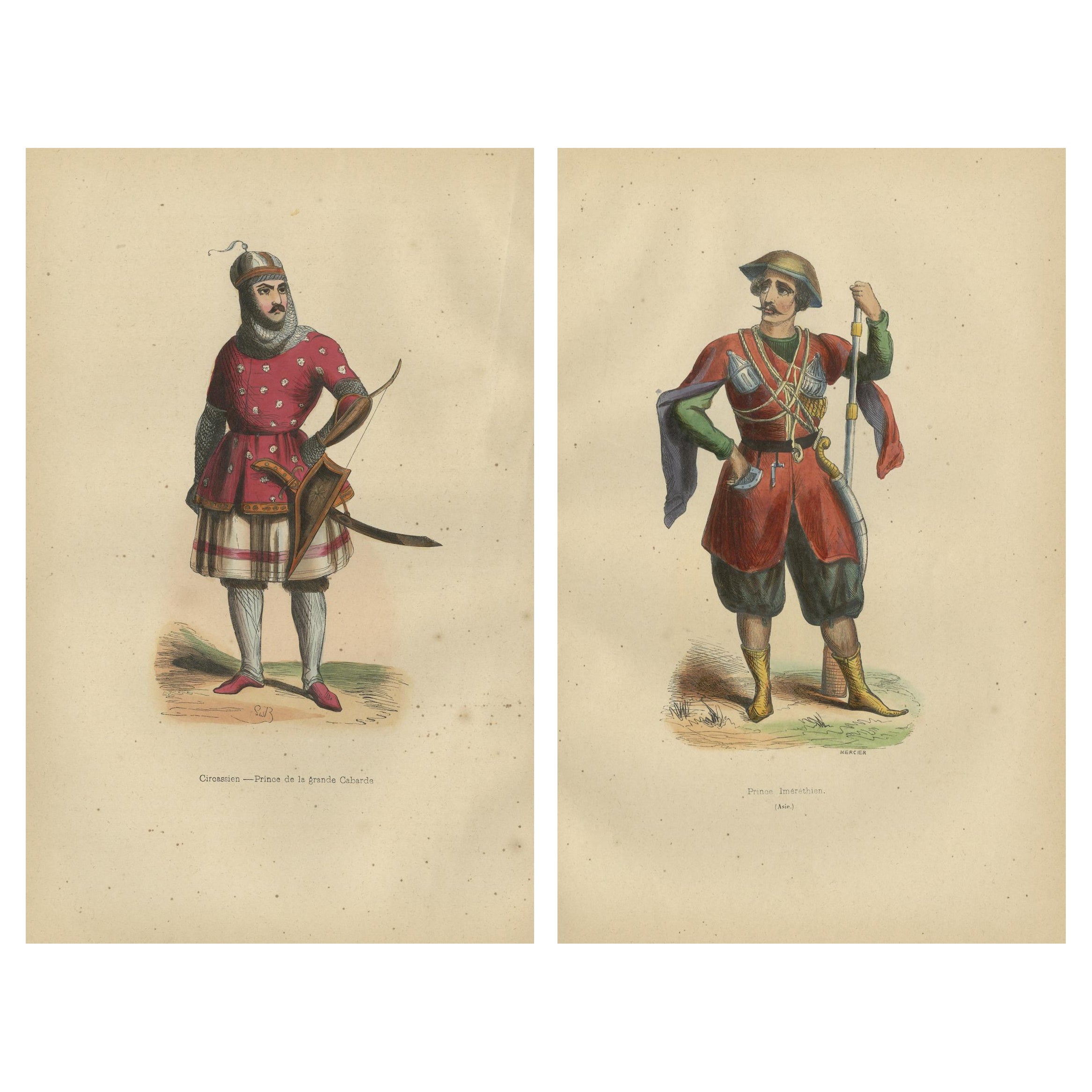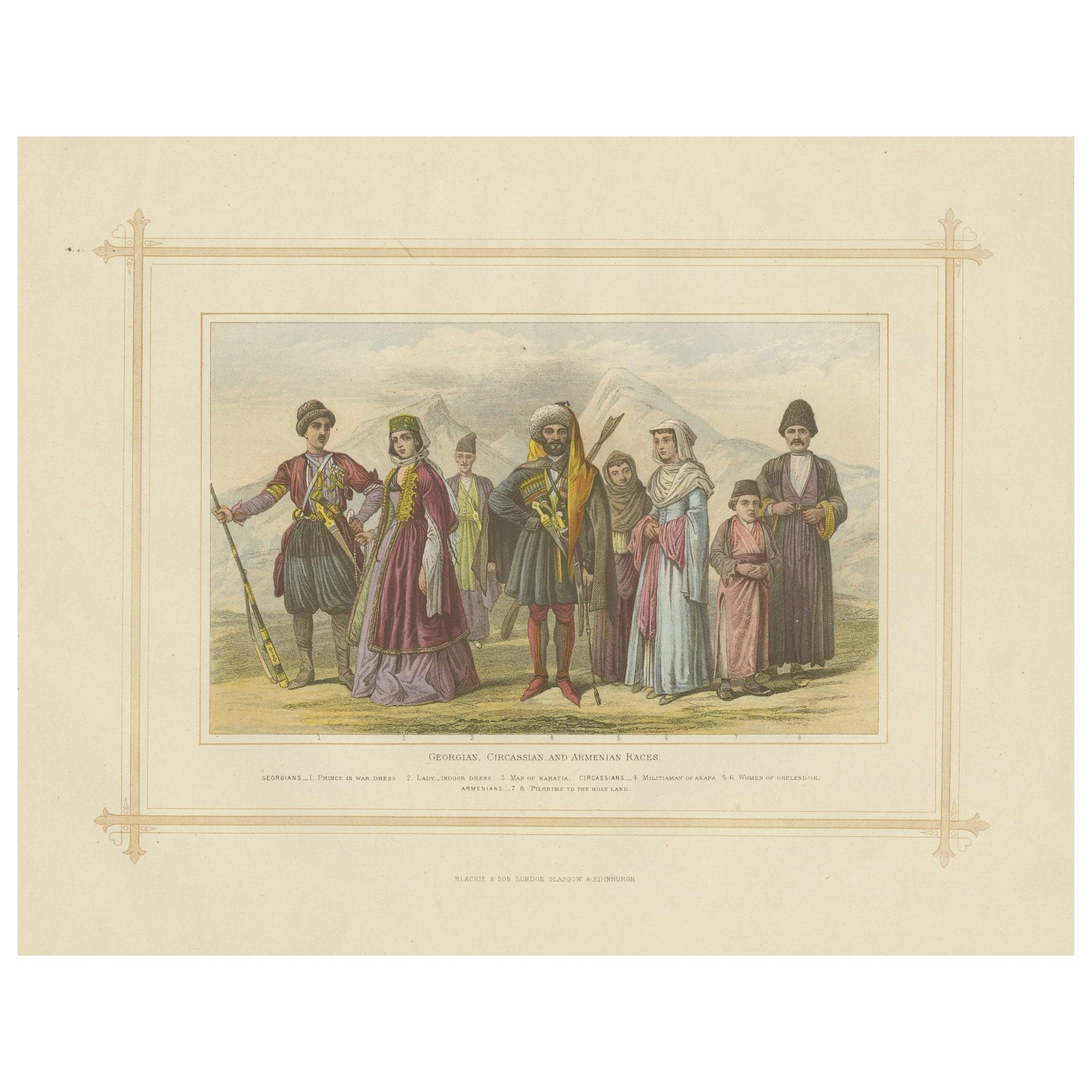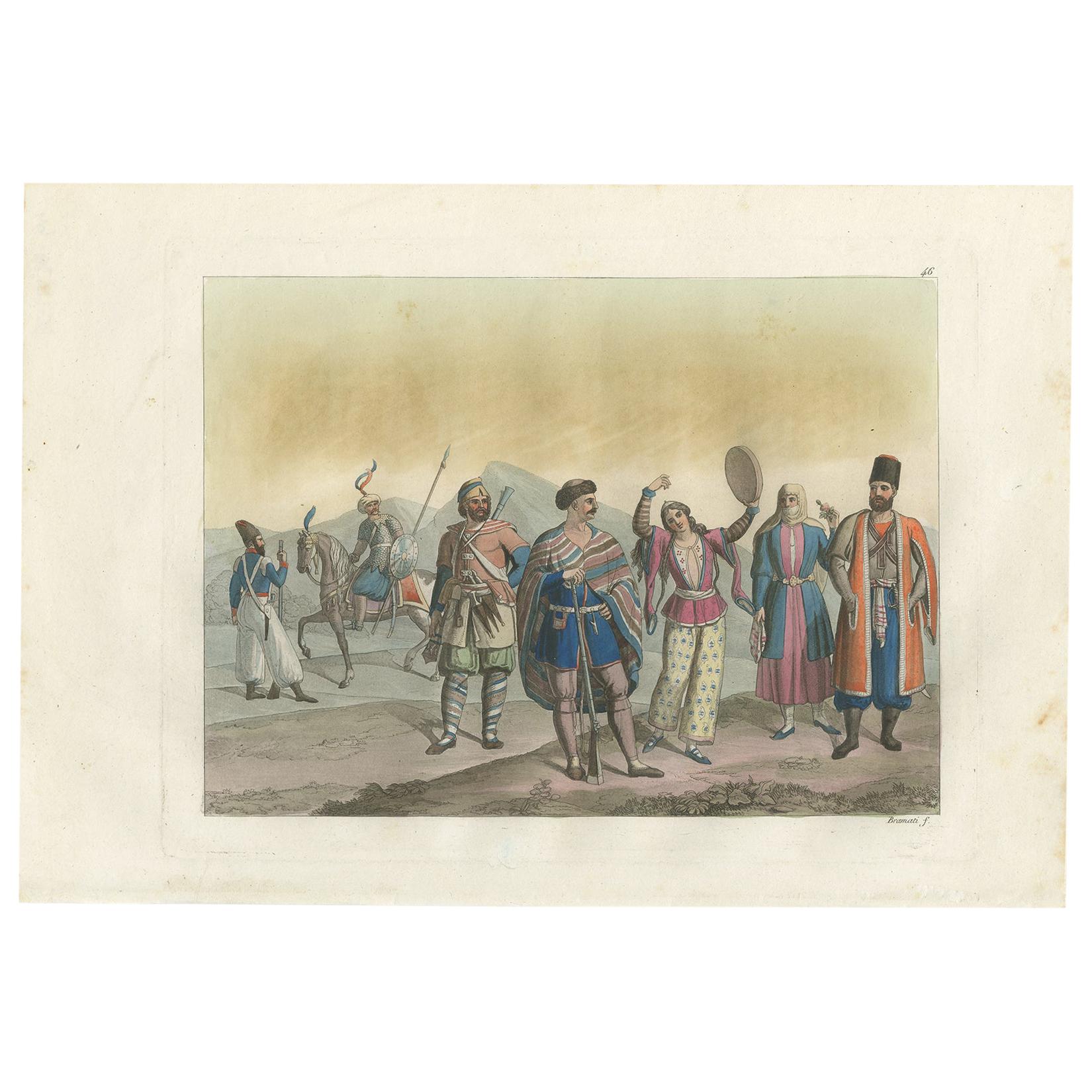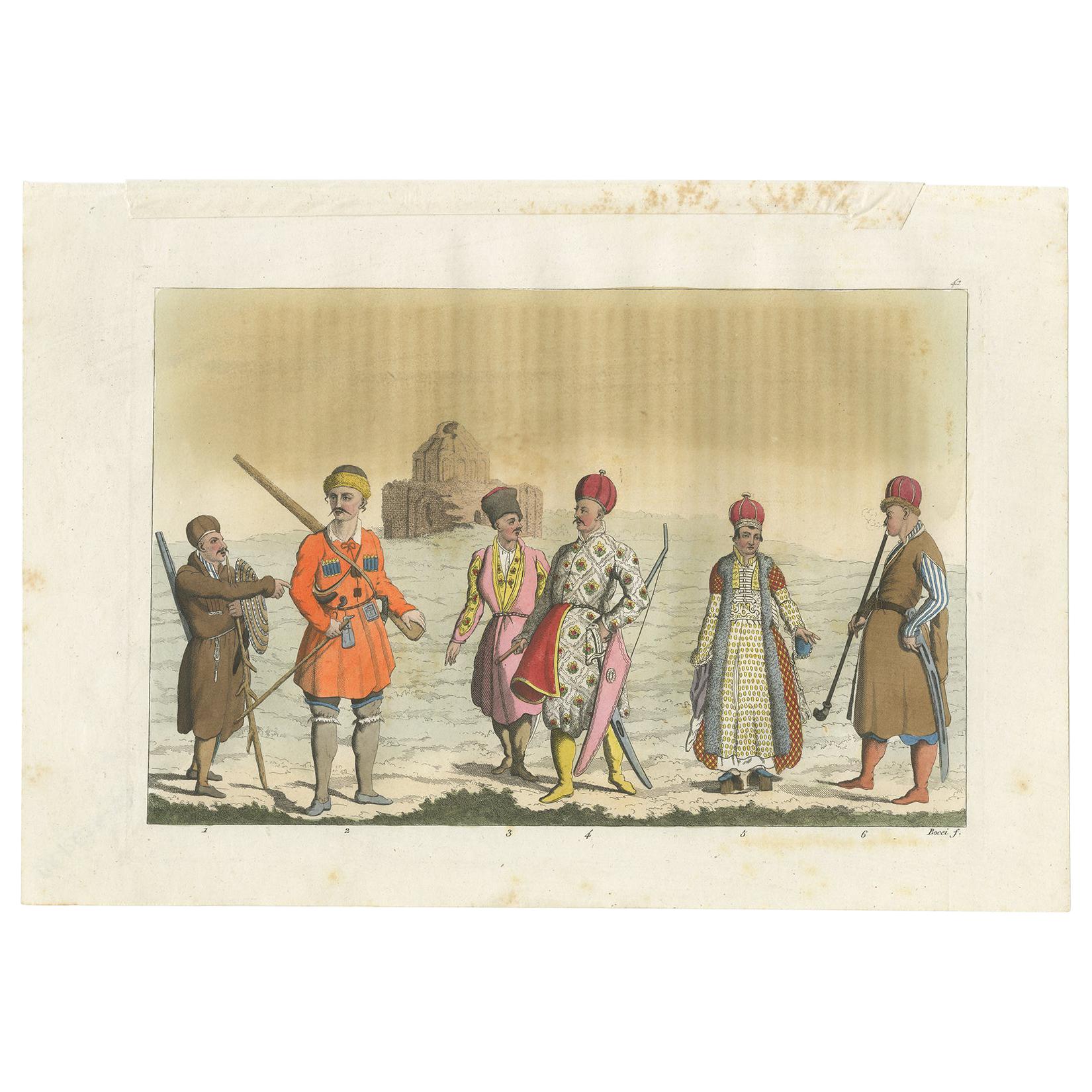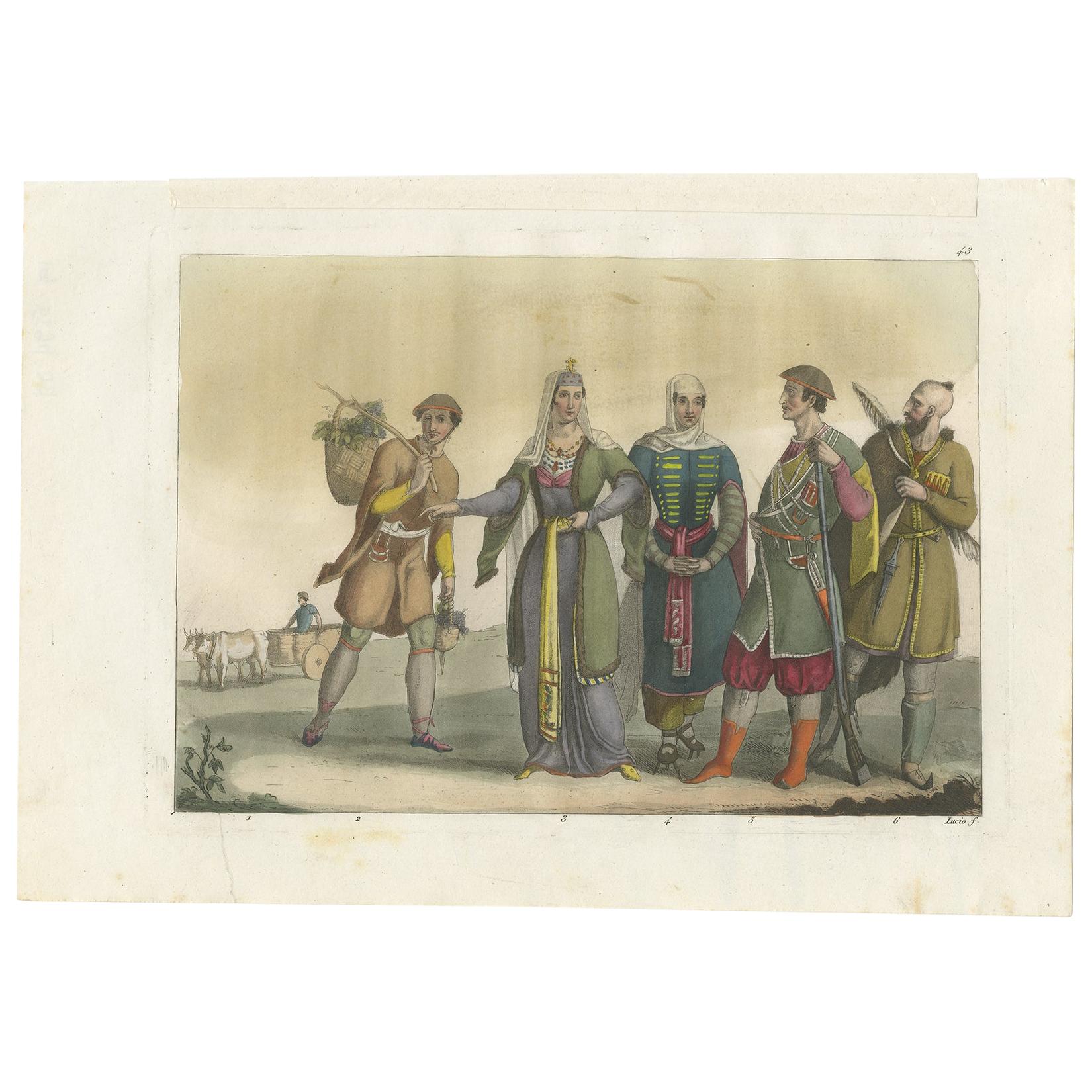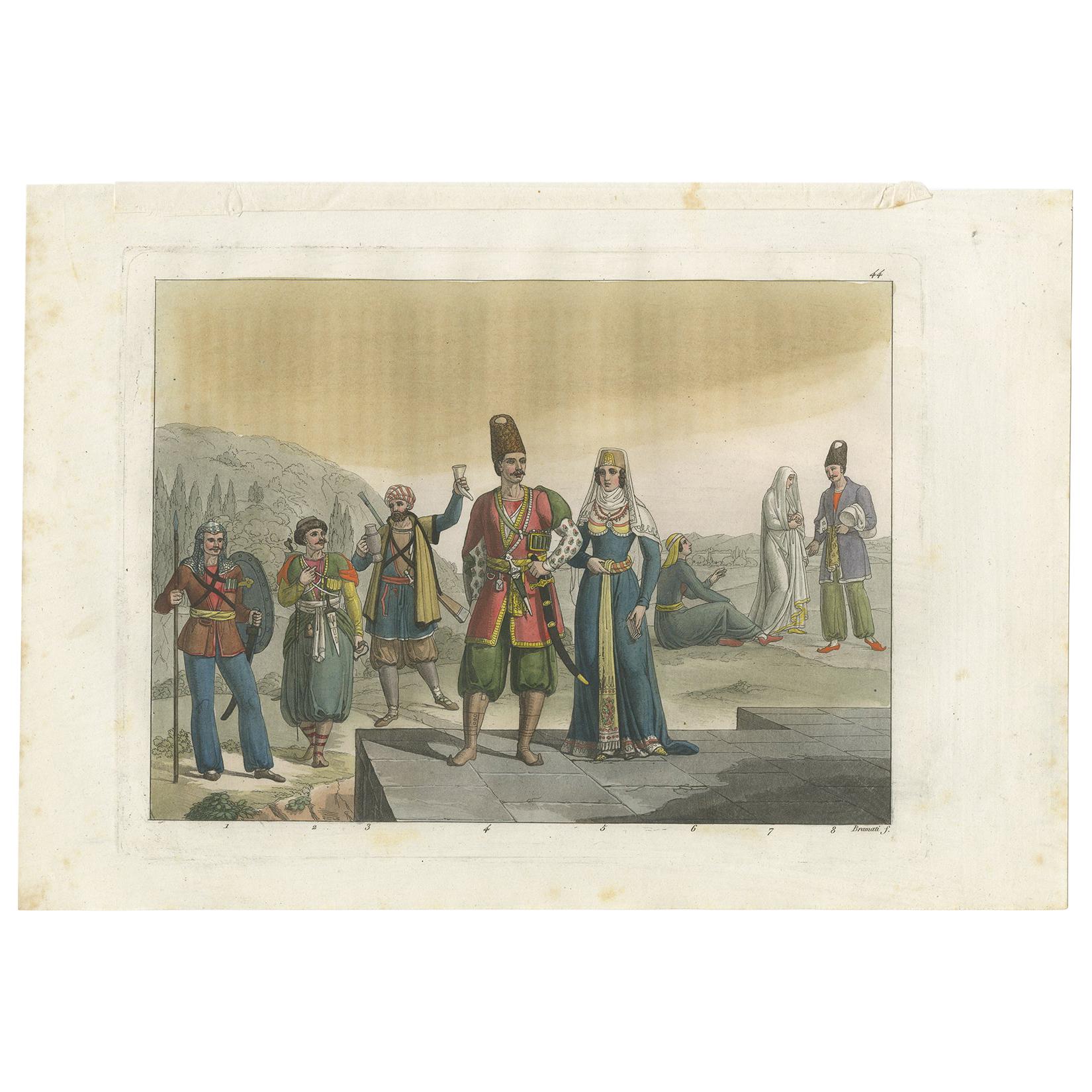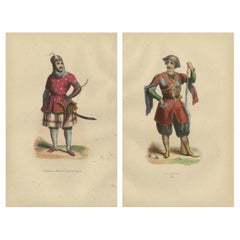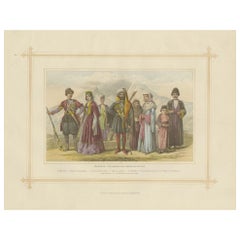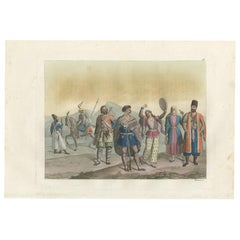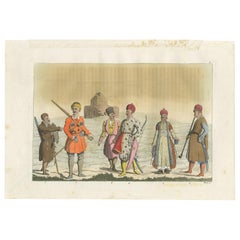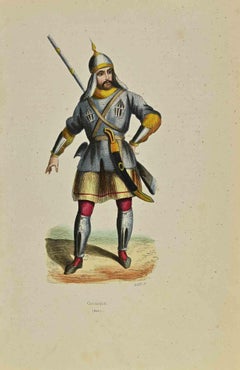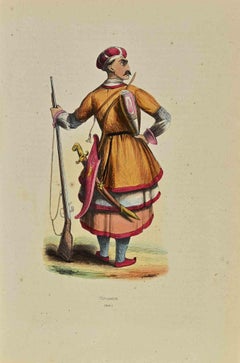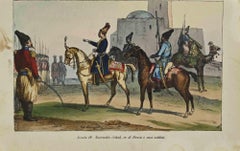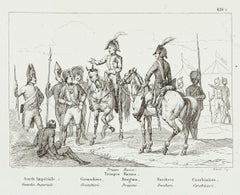Items Similar to Circassian Grandee and Commoner – An 1800 Etching by Geissler
Want more images or videos?
Request additional images or videos from the seller
1 of 7
Circassian Grandee and Commoner – An 1800 Etching by Geissler
$645.72
$807.1520% Off
£487.24
£609.0520% Off
€544
€68020% Off
CA$899.99
CA$1,124.9920% Off
A$978.32
A$1,222.9020% Off
CHF 512.73
CHF 640.9120% Off
MX$11,906.97
MX$14,883.7220% Off
NOK 6,453.99
NOK 8,067.4820% Off
SEK 6,064.65
SEK 7,580.8120% Off
DKK 4,143.85
DKK 5,179.8120% Off
About the Item
Etching and engraving entitled 'A Grandee of Circassia arrayed with his full accoutrements and a Circassian of the lower class, in his shaggy cloak, called Burki'. Lettered 'Geissler delt. Grainger sculp.'.
This etching, crafted around 1800 by the artist Geissler and engraved by Grainger, presents a striking depiction of a Circassian noble, known as a Grandee, in full traditional attire and a commoner dressed in a shaggy cloak called a Burki. The detailed illustration contrasts the societal ranks within Circassia through the lens of attire, capturing the grandeur of a high-ranking individual alongside the simplicity of lower-class garb. This work offers a window into the cultural and social stratifications of early 19th-century Circassia.
The individuals depicted in the engraving are from Circassia, a region in the Caucasus. The term "Circassian" typically refers to the indigenous peoples of this area, which include various tribes such as the Adyghe. The grandee would likely belong to one of the noble tribes, while the man in the burki, a lower-class garment, would be from a common tribe within the Circassian ethnic group.
- Dimensions:Height: 10.44 in (26.5 cm)Width: 7.88 in (20 cm)Depth: 0 in (0.02 mm)
- Materials and Techniques:Paper,Engraved
- Period:
- Date of Manufacture:circa 1800
- Condition:Excellent condition, especially considering its age of over 200 years. This is not a reproduction but an original engraving. Study the image carefully.
- Seller Location:Langweer, NL
- Reference Number:Seller: BG-13597-151stDibs: LU3054337816722
About the Seller
5.0
Recognized Seller
These prestigious sellers are industry leaders and represent the highest echelon for item quality and design.
Platinum Seller
Premium sellers with a 4.7+ rating and 24-hour response times
Established in 2009
1stDibs seller since 2017
2,692 sales on 1stDibs
Typical response time: <1 hour
- ShippingRetrieving quote...Shipping from: Langweer, Netherlands
- Return Policy
Authenticity Guarantee
In the unlikely event there’s an issue with an item’s authenticity, contact us within 1 year for a full refund. DetailsMoney-Back Guarantee
If your item is not as described, is damaged in transit, or does not arrive, contact us within 7 days for a full refund. Details24-Hour Cancellation
You have a 24-hour grace period in which to reconsider your purchase, with no questions asked.Vetted Professional Sellers
Our world-class sellers must adhere to strict standards for service and quality, maintaining the integrity of our listings.Price-Match Guarantee
If you find that a seller listed the same item for a lower price elsewhere, we’ll match it.Trusted Global Delivery
Our best-in-class carrier network provides specialized shipping options worldwide, including custom delivery.More From This Seller
View AllCircassian and Imeretian Princes in Traditional Attire, 1844 Lithographs
Located in Langweer, NL
Title:"Circassian and Imeretian Princes in Traditional Attire, 1844 Lithographs"
This horizontal compilation features two lithographs from Auguste Wahlen's 1844 series, "Moeurs, Usages et Costumes de tous les Peuples de Monde," depicting princes from Circassia and Imeretia in traditional attire.
These prints, made using handcoloured lithography, highlight the distinctive cultural dress and accessories of these regions in Asia.
The Circassian prince is adorned in a decorative military-style outfit, complete with armor and a bow, symbolizing his warrior status. The Imeretian prince's attire is similarly martial but incorporates more vivid colors and a less formal style, reflecting the different ceremonial and functional aspects of his region's attire.
The attractiveness of these prints lies in their vibrant coloration and meticulous detail, which not only make them visually striking but also serve as valuable historical records of cultural heritage and traditional dress. The technique of handcoloured lithography allows for precise detail and rich hues, enhancing the visual impact and historical authenticity of each figure.
Keywords:
- Antique Circassian prints
- Imeretian historical attire
- Handcoloured lithographs
- 19th-century cultural costumes
- Auguste Wahlen artwork
- Collectible historical prints
- Traditional warrior attire lithographs
- Asian prince...
Category
Antique 1840s Prints
Materials
Paper
$246 Sale Price / set
20% Off
Decorative Antique Lithograph of the Georgian, Circassian & Armenian Races, 1882
Located in Langweer, NL
Experience a captivating glimpse into the world of 19th-century ethnography with the "Georgian, Circassian and Armenian Races", an antique print from Blackie's Comprehensive Atlas an...
Category
Antique 1880s Prints
Materials
Paper
$180 Sale Price
20% Off
Antique Print of Natives of Persia and Other People by Ferrario '1831'
Located in Langweer, NL
Original antique print of natives of Persia and other people. Original handcolored.
This print originates from 'Costume Antico e Moderno: Palestine, China, India, Oceania' by Ferrar...
Category
Antique Mid-19th Century Prints
Materials
Paper
$284 Sale Price
20% Off
Antique Print of Ingush and Other People by Ferrario '1831'
Located in Langweer, NL
Original antique print of Ingush and other people. This print originates from 'Costume Antico e Moderno: Palestine, China, India, Oceania' by Ferrario. Published 1831.
Category
Antique Mid-19th Century Prints
Materials
Paper
$284 Sale Price
20% Off
Antique Print of Natives of Imereti and Other People by Ferrario, '1831'
Located in Langweer, NL
Original antique print of natives of Imereti and other people. This print originates from 'Costume Antico e Moderno: Palestine, China, India, Oceania' by Ferrario. Published 1831.
Category
Antique Mid-19th Century Prints
Materials
Paper
$284 Sale Price
20% Off
Antique Print of Natives of Georgia and Other People by Ferrario '1831'
Located in Langweer, NL
Original antique print of natives of Georgia and other people. This print originates from 'Costume Antico e Moderno: Palestine, China, India, Oceania' by Ferrario. Published 1831.
Category
Antique Mid-19th Century Prints
Materials
Paper
$284 Sale Price
20% Off
You May Also Like
Circassian - Lithograph by Auguste Wahlen - 1844
Located in Roma, IT
Circassian is a lithograph made by Auguste Wahlen in 1844.
Hand colored.
Good condition.
At the center of the artwork is the original title "Circassien".
The work is part of Suit...
Category
1840s Modern Figurative Prints
Materials
Lithograph
Circassian - Lithograph by Auguste Wahlen - 1844
Located in Roma, IT
Circassian is a lithograph made by Auguste Wahlen in 1844.
Hand colored.
Good condition.
At the center of the artwork is the original title "Circassien".
The work is part of Suit...
Category
1840s Modern Figurative Prints
Materials
Lithograph
Nasereddin Shah, King of Persia and his Soldiers- Lithograph - 1862
Located in Roma, IT
Persian Cloth in 19th Century is a Hand-colored lithograph on paper realized in 1862.
The artwork belongs to the Suite Uses and customs of all the peoples of the universe: " History...
Category
1860s Modern Figurative Prints
Materials
Lithograph
Russian Guards - Lithograph - 19th Century
Located in Roma, IT
Imperial Guards is an original print on paper realized by an Anonymous. titled on the lower of image.
In very good conditions.
Sheet dimension: 18 x 25.5 cm
The artwork represents...
Category
19th Century Figurative Prints
Materials
Lithograph
19th Century Hand-Colored Copper Engraving of an Arab Warrior
By Adja Yunkers
Located in Hamburg, DE
This striking 19th-century hand-colored copper engraving depicts a detailed portrait of an Arab armed warrior, complete with a French subtitle specifying his exact designation. The c...
Category
Antique 19th Century French Biedermeier Prints
Materials
Wood, Paper
Original Antique Ethnographical Print of Indigenous Siberians. C.1780
Located in St Annes, Lancashire
Wonderful print of indigenous Siberians
Copper-plate engraving
Published C.1780
Unframed.
Category
Antique 1780s English Georgian Prints
Materials
Paper
More Ways To Browse
Oyster Burl
Painted Black Lacquer Chest
Painted Red Distressed
Paradis Paris
Pea Pod
Persian Calligraphy
Perugia Italy
Pink Glass Bird
Plaster Angels
Polychrome Chest Of Drawers
Portuguese Majolica Plate
Poseidons Trident
Purple Pedestal
Rabbit Chair By Stefano Giovannoni
Rabbit Figurine
Raku Tea
Ram Skull
Red Crystal Bowl
